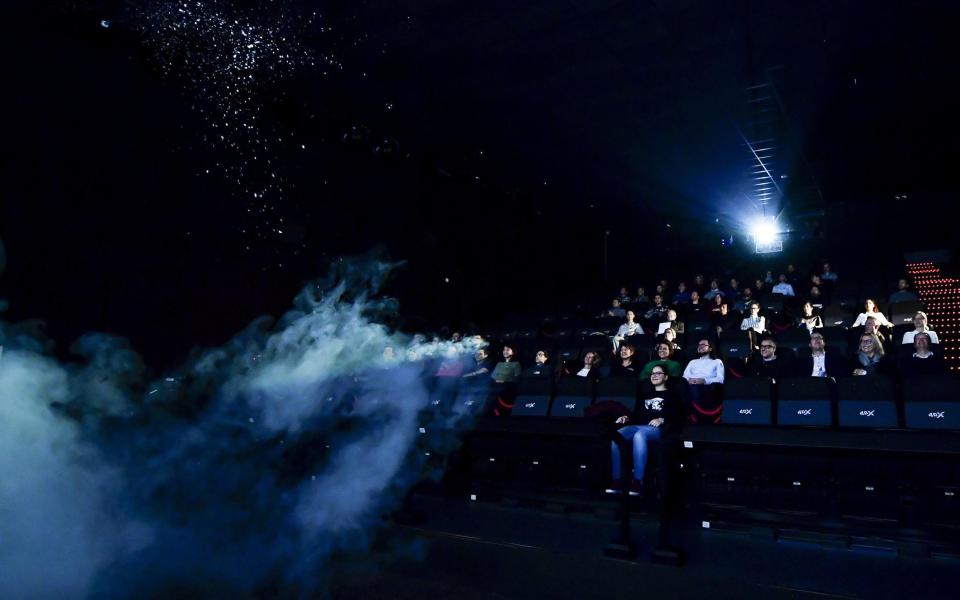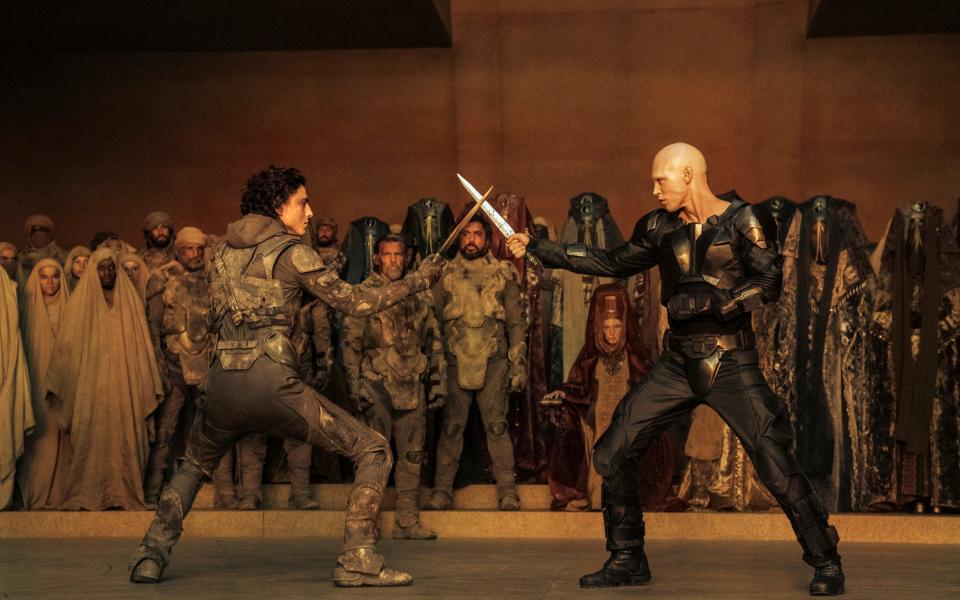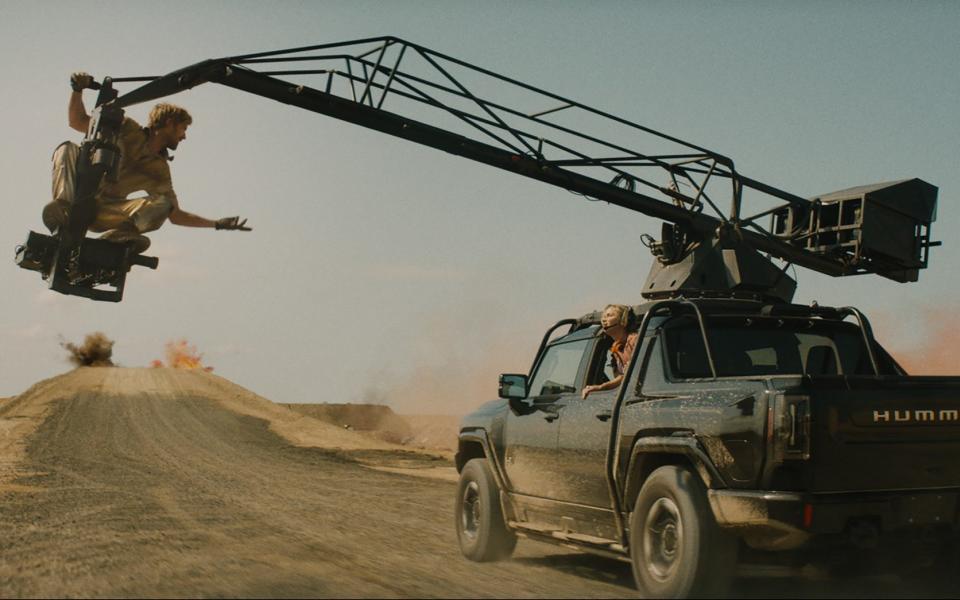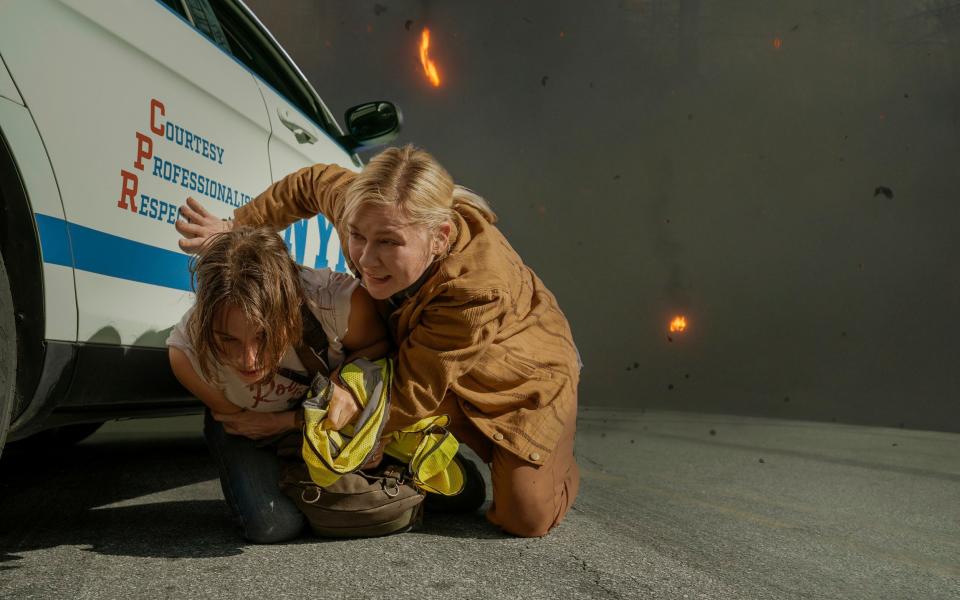Films you can feel: How 4DX went from silly gimmick to the saviour of cinema

“We can hit you with 10 smells,” the technician explains, pointing to a nozzle around three feet from my face.
“Not all at once, obviously. But over the course of the film. We’ve got florals – meadows, blossoms, freshly cut grass. We’ve got sweets – we created a chocolate one especially for Wonka. Then there are the atmospherics – salty ocean breezes, brewing coffee, freshly baked bread, gunpowder, burning rubber for car chases. And for the Teenage Mutant Ninja Turtles last year,” he adds with obvious pride, “we introduced cheese.”
I am sitting in the 4DX cinema at the O2 in Greenwich, south east London, surrounded by a rig of concealed pistons and flanges. And if you have yet to experience a film in 4DX – “watch” feels like the wrong word – these devices work together to create 21 different multi-sensory effects that match up with the action on screen.
Some cause you–r chair to tilt, roll and twist through three axes, others make it convulse and vibrate. Others still, embedded in the headrests of your own seat and the seat in front, spray and/or shower your with water (which can be toggled on and off), emit aromas, tickle your ankles and puff warm air into your ears. At the front, on either side of the screen at floor level, are smoke machines, capable of creating waves of fog that roll to the back of the room. High on the walls are strobe lights and fans that blow bubbles, scatter fake snow, generate breezes and splash yet more water across the entire audience from a height.
Is this the future of cinemas, or a preposterous gimmick? And does one of these necessarily rule the other out? Speaking on the Today programme in February, Martin Scorsese expressed doubt over films that leant on “chairs that bounce around”, “certain scents,” and so on, and wondered if they would still be worth seeing without them.
And at first blush, 4DX certainly sounds like a 21st century take on the flash-in-the-pan stunts filmmakers like William Castle used to sell otherwise unmemorable B-movies in the 1950s and 1960s. Castle was a journeyman director but a showman par excellence, luring in audiences with novelties such as ‘Emergo’ (a plastic skeleton with light-up eyes that dropped from the ceiling on a rope) and “Percepto” (a motorised buzzer embedded in the seat cushion, which his company made from repurposed aircraft wing de-icers).
But each of Castle’s tricks was attached to a specific picture, and died on the whim of the box office: 4DX, on the other hand, is proving rather long-lived. After launching in South Korea with the release of the original Avatar, then expanding worldwide – first into Latin America, and arriving in the UK in 2015, via Milton Keynes – the technology is about to celebrate its 15th birthday, and is in enviable commercial shape.

There are currently 35 4DX screens operating in the UK – all in branches of Cineworld, which has exclusive rights to the format here – and almost 800 worldwide. In the first half of last year, ticket sales for the format reached £189 million: 70 per cent higher than the equivalent period in 2022, and 33 percent up on its pre-pandemic record.
In the UK, around 40 films a year are made available in 4DX, and those that are still make far more money from ordinary showings. (The most popular release of 2023 was the Super Mario Bros animation, but here, 4DX screenings accounted for only four per cent of its overall takings.)
Because of the higher admission fees, however – £56 for a family of four in Greenwich, as opposed to £32 for the vanilla version – the takings per screen can be enormous. And for those in the mood to be jostled and spritzed, 4DX is another good reason to catch a film during its initial theatrical run: no wonder Hollywood is warming to the format. Recent market research shows that customers are willing to travel twice as far for one of these enhanced screenings as for a normal cinema trip. No matter how wide your television may be, or loud your hi-fi, here is an area in which home viewing – and cinema’s arch nemesis, Netflix – can never compete.

But which films are selected for the 4DX treatment? “We used to scan the release schedules, work out which titles would work best in the format, and then make our pitch to the studios,” explains Bobbie Andrews, the managing director of 4DX in the UK. “But as they’ve realised the added value it can bring – both commercially and in terms of their customers’ enjoyment – we find they’re now getting in touch with us just as much.”
When programming, the company “tend[s] to stay in our lane,” Andrews says. “Normally it’s very obvious which films will work and which won’t.” This year’s biggest hits so far included Dune: Part Two – perhaps an improbably sombre candidate for the 4DX treatment, especially when you factor in the desert planet of Arrakis’s famed lack of H2O.
But the company’s programmers made it work for them, with seat-based vibrations which mirrored the rhythmic pounding of the Fremen’s thumpers – the cylindrical gizmos used to summon sandworms – and the soul-shaking ructions of ‘The Voice’, the Bene Gesserit’s signature mind-control technique. Elsewhere, puffs of dry ice kicked in during sandstorms, and the seats pitched and yawed in sync with Timothée Chalamet’s first-person sandworm ride, and the various soaring camera manoeuvres high above the sands.

More lighthearted forthcoming attractions include next month’s action comedy The Fall Guy, starring Ryan Gosling as a stunt man who becomes embroiled in a criminal conspiracy (brace for burning rubber), and July’s Twisters, a sequel to the 1996 tornado-chaser romp (pack cagoules).
“Children’s animations are also reliably strong sellers for us, and horror films that go heavy on jump scares,” Andrews adds. “Our strong suit is anything that feeds off that collective, in-the-moment audience delight.” Though the technology isn’t related, most 4DX films are also screened in 3D: if they aren’t, says Andrews, “customers sometimes feel they’re a D short.”
But how to talk the comparatively reserved British cinema-going public into trying it? The breakthrough, Andrews says, came with the rise of online influencer culture. “You can tell people what happens during a 4DX film, but they’re far likelier to be tempted to try it after seeing their favourite TikTokker enjoying it.”

There is another unique selling point that can’t be advertised without offending clients: 4DX can turn a bad or uninspiring film into a hoot. My own children were largely unmoved by Kung Fu Panda 4, but had a whale of a time rewatching it two weeks later in smell, thump and wobble-vision, even remarking afterwards how much more the whole audience had been laughing throughout.
A (grown-up) friend who swears by the format feels similarly. “I basically never go and see a ‘good’ film in 4DX,” he writes. “What a terrible idea that would be.” His favourite so far? “Super Mario Bros. We were all crying with laughter during the big Mario Kart bit.”
The unlikeliest 4DX release to date, says Andrews, was probably Alex Garland’s Civil War earlier this month – an action movie, yes, but an unusually cerebral and grounded one. We watch an excerpt, and the technology is deployed to impressively subtle effect, as the seats gently pitch forward and backward to mimic the changes in speed in Kirsten Dunst’s vehicle as it comes to a halt at a road block, with a draught of cold air as the driver’s window is wound down, and a vibrational shift as the tyres move off the covered road. It’s certainly different from the opening scene of Godzilla x Kong, which in 4DX feels being kicked through a car wash.

Taste has always been a deal-breaker, and rightly so: the blood congeals at the thought of, say, 4DX Schindler’s List. That was why the company quickly decided not to ask Universal if they could produce an enhanced version of Oppenheimer, even when it became clear it was going to be one of last year’s biggest films. But even Christopher Nolan, a noted booster of the pure theatrical experience, isn’t averse to the technology per se: it’s been applied to a number of his earlier works, from the Dark Knight trilogy to Tenet.
Every year, around 100 films are converted into 4DX – a process that takes around two or three weeks at their South Korean headquarters. (The company is a subsidiary of CJ Group, an enormous Seoul-based conglomerate, which branched off from Samsung in the 1990s.) Typically they work in consultation with a producer or editor – but usually the director, and sometimes the star, will sign off on the finished product. (The last tier of quality control on Mission: Impossible – Dead Reckoning Part One was Tom Cruise.)
Two teams are involved, both of whom work on a finished digital print of the film: the hardest part of wooing studios, Andrews explains, was persuading them the company’s anti-piracy firewalls were airtight. One team covers effects, dragging the triggers for water, smells, fog et cetera onto a digital timeline synched to the finished film. And the second works on motion, mapping out and timing the various seat movements and vibrations. Over the past decade and a half, a vast vibratory library has been assembled – there are four shaking patterns for aircraft cabins alone – but they can also be fine-tuned as required.
“It sounds like engineering, but we call them artists,” says Andrews, “because when you’ve seen them at work, there’s no question that what they do is art.”
Rather than introducing a 22nd effect – ice cubes down your neck, maybe – the future of 4DX involves another of CJ Group’s technological wheezes. ScreenX, created in 2012, is another innovative format, in which additional screens on the left and right walls of the cinema flood the audience’s peripheral vision. ScreenX versions of films take up to three months to create, and are considerably more work than 4DX ones.
The company has its own in-house visual effects team which creates the peripheral footage from scratch, using elements drawn from the finished film, the studio’s broader cache of VFX data, and (in rare cases such as Top Gun: Maverick) additional live-action footage captured during the shoot. It takes a few minutes to acclimatise – at first it feels as if you’re watching the film from inside a giant gerbilarium. But once the initial distraction factor ebbs, an almost Imax-like feeling of being inside the image creeps in: in Dune: Part II, the wide-open desert vistas really do feel endless.
The first Ultra 4DX screen, which combines both 4DX and ScreenX technologies, opened in South Korea in 2017, and the technology is being rolled out, albeit slowly: there are four screens currently operating in Europe, Africa and the Middle East.
The nearest is in Paris, if you want to make the trip. And devotees have been known to make pilgrimages. “We heard about a guy in Germany the other week who drove two and a half hours from Leipzig to Kassel just to see the 4DX version of Dune: Part Two, when the normal version was showing minutes from his house,” Andrews says.
“But one thing I love about the format is that it always rewards the trip – it’s a particular communal experience you can’t have anywhere else.” In cinema’s post-covid war on the sofa and the smartphone, it might be the shot in the arm – or rather the squirt in the face – that the industry needs.

